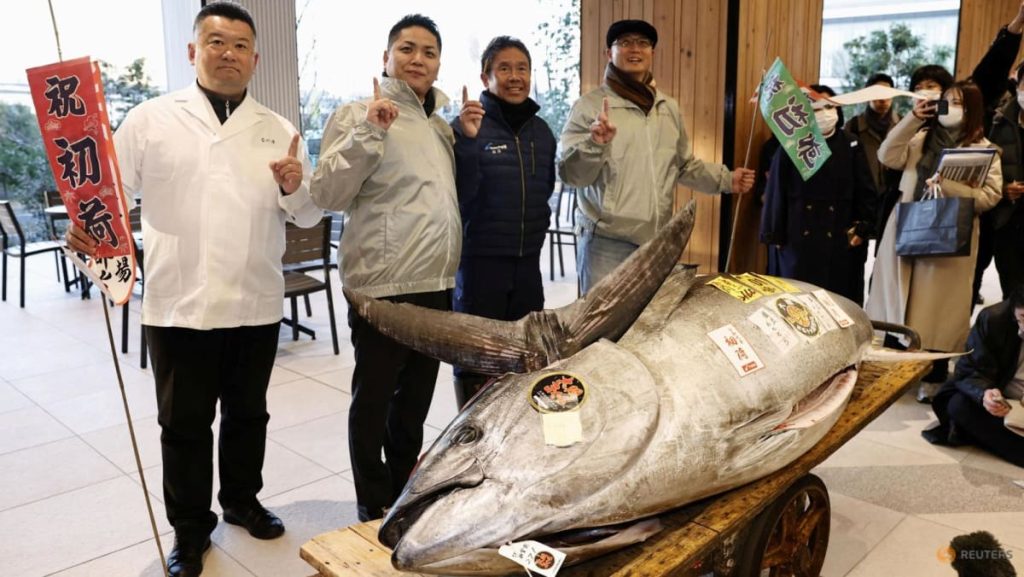The dawn of the New Year in Tokyo is heralded not by the chiming of bells, but by the resounding clang of the auctioneer’s gavel at the Toyosu fish market. This year, the ceremonial first tuna auction, a deeply ingrained tradition and a spectacle of both culinary extravagance and cultural significance, witnessed another breathtaking display of opulence. The Onodera Group, a renowned name in the world of high-end sushi, secured the prized catch – a colossal 276-kilogram bluefin tuna – for a staggering 207 million yen, equivalent to approximately US$1.3 million. This eye-popping figure marks the second-highest price ever paid for a single fish at the prestigious New Year auction, trailing only the record-breaking sum of over US$3 million paid in 2019, incidentally also by the Onodera Group.
The annual tuna auction at Toyosu, the successor to the iconic Tsukiji fish market, transcends a mere commercial transaction. It is a highly symbolic event steeped in tradition, representing a celebration of the ocean’s bounty and a prayer for prosperity in the coming year. The first tuna of the year, often a behemoth bluefin, is considered an auspicious symbol, believed to bring good fortune and abundance to the purchaser. The exorbitant prices paid reflect not only the perceived value of the fish itself – a testament to its size, quality, and rarity – but also the intangible benefits associated with winning the auction. The victor gains not only the prized tuna but also invaluable bragging rights and a torrent of media attention, solidifying their status as a purveyor of the finest seafood.
For the Onodera Group, this year’s triumph marks a remarkable fifth consecutive victory, cementing their dominance in the high-stakes world of tuna acquisition. This consistent success underscores their unwavering commitment to procuring the highest quality ingredients, a cornerstone of their reputation for serving exquisite sushi experiences. The group, helmed by Michelin-starred chef Akifumi Noma, operates a string of exclusive sushi restaurants both in Japan and internationally, catering to discerning clientele who appreciate the artistry and dedication that go into crafting the perfect sushi. Their willingness to invest such a significant sum in a single fish reflects their dedication to providing their patrons with the most exceptional dining experience possible.
Beyond the immediate gratification of securing the prized tuna, the Onodera Group’s participation in the auction carries a deeper meaning. Shinji Nagao, an official representing the group, articulated this sentiment when he stated that the first tuna is intended to bring good fortune, expressing their hope that people consuming it would experience a wonderful year. This statement highlights the cultural significance of the auction, transcending the purely commercial aspects of the transaction. The act of purchasing the first tuna becomes a symbolic gesture, expressing a desire for prosperity and well-being, not just for the purchaser, but for the wider community.
The exorbitant price tag inevitably raises questions about the sustainability of such practices and the future of bluefin tuna, a species facing significant challenges due to overfishing. The intense demand for high-grade tuna, particularly in Japan, has contributed to the depletion of bluefin populations, raising concerns among conservationists. While the annual auction provides a dramatic illustration of the high value placed on this prized fish, it also serves as a stark reminder of the need for responsible fishing practices and sustainable consumption patterns. The future of bluefin tuna, and the continuation of traditions like the New Year auction, hinges on striking a balance between economic interests and environmental preservation.
The story of the US$1.3 million tuna is more than just a tale of extravagant spending. It’s a glimpse into a deeply rooted cultural tradition, a testament to the enduring allure of a prized delicacy, and a reflection of the complex interplay between commerce, culture, and conservation. The clang of the gavel at the Toyosu fish market reverberates far beyond the confines of the auction hall, echoing the challenges and complexities surrounding the future of one of the ocean’s most magnificent creatures. It serves as a potent reminder that the pursuit of culinary excellence must be tempered with a commitment to preserving the resources that make it possible.

